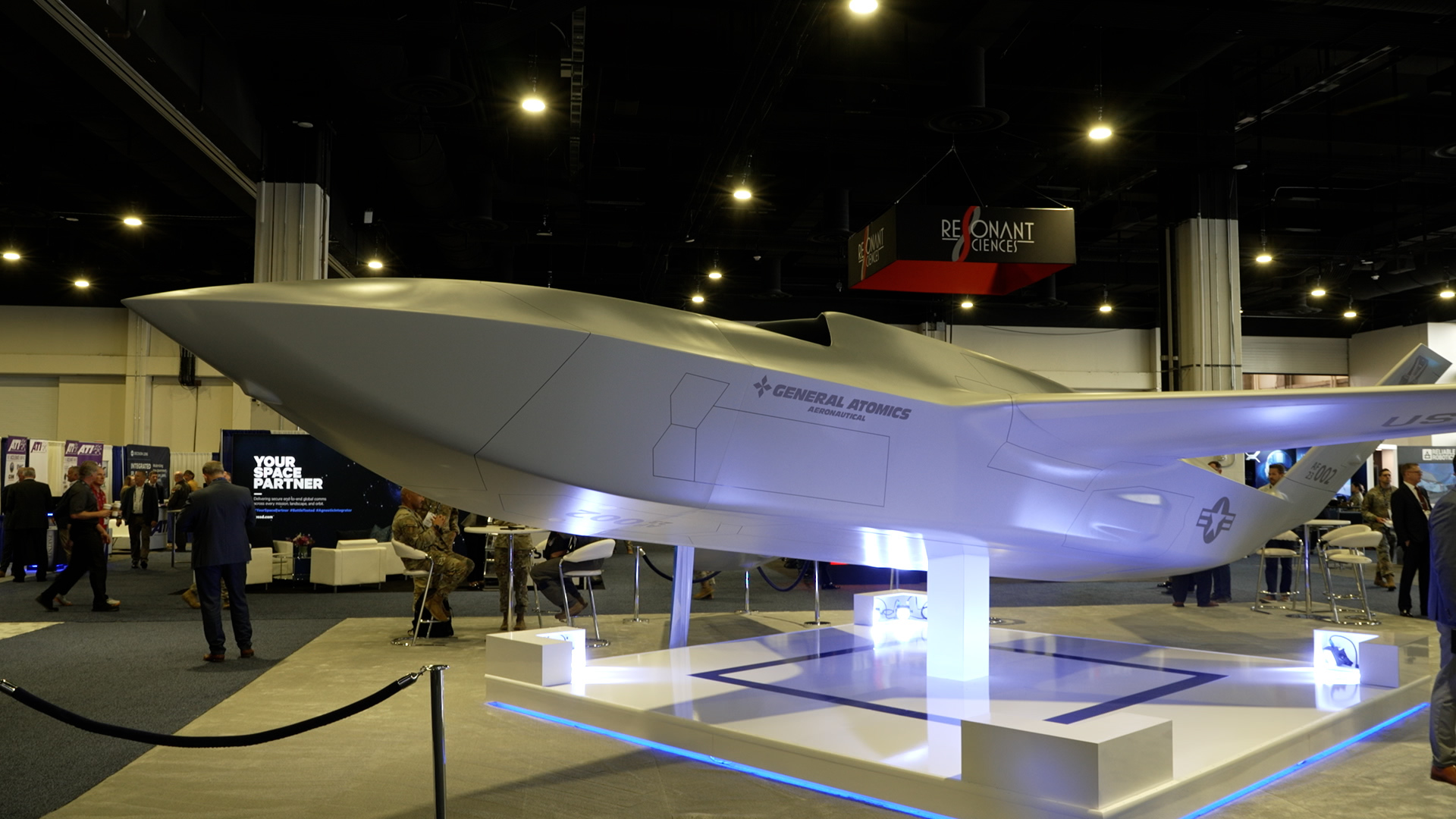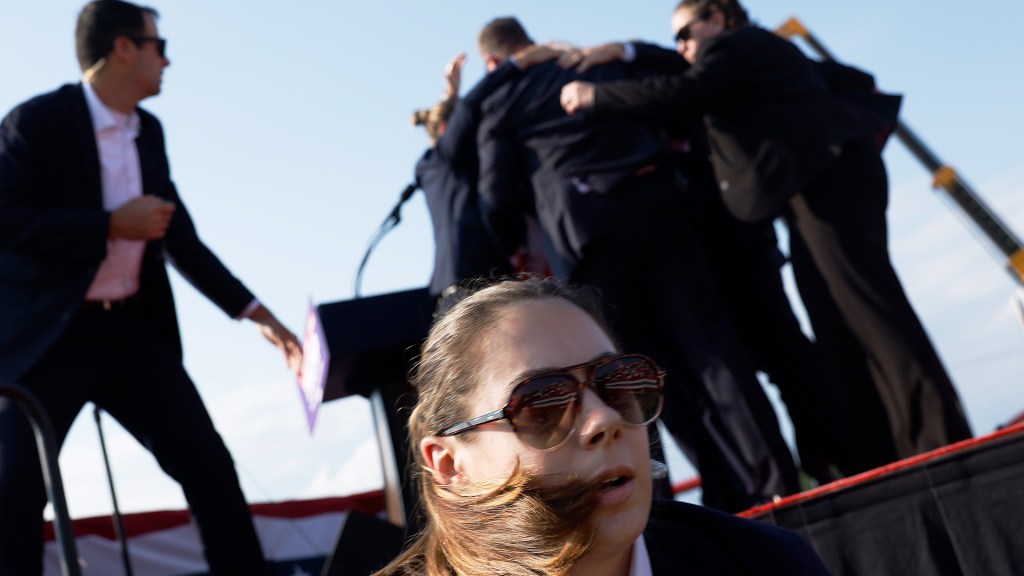
[RYAN ROBERTSON]
A LITTLE MORE THAN TWO YEARS AGO, SECRETARY OF THE AIR FORCE FRANK KENDALL ANNOUNCED PLANS FOR THE AIR FORCE TO BUILD A FLEET OF AUTONOMOUS DRONES THAT WOULD FLY INTO COMBAT ALONGSIDE CREWED PLATFORMS.
CALLED THE COLLABORATIVE COMBAT AIRCRAFT, FIVE COMPANIES WERE SELECTED FOR THE INITIAL ROUND OF COMPETITION FOR THE CONTRACT. LOCKHEED MARTIN, BOEING, NORTHROP GRUMMAN, GENERAL ATOMICS AND ANDURIL.
IN APRIL, THAT NUMBER WAS WHITTLED DOWN TO TWO: GENERAL ATOMICS AND ANDURIL, AND AT AIR, SPACE AND CYBER 2024, WE GOT OUR FIRST LOOK AT THE FINALISTS. THAT’S WHY THE C-C-A IS OUR WEAPON OF THE WEEK.
COLLABORATIVE COMBAT AIRCRAFT REPRESENT A LOT OF CHANGES FOR U-S AIR POWER….BUT AT THEIR CORE, THESE ARE STILL PLANES.
[PHIL EWING]
But I can tell you that it would operate just like a fighter. So it has landing gear. It would roll out from a hangar, it would take off, it would climb and cruise ahead of or alongside a traditional combat fighter formation, and in that way, it would look very familiar with the big difference that there’s nobody on board.
[RYAN ROBERTSON]
PHIL EWING IS THE SPOKESPERSON FOR GENERAL ATOMICS–ONE OF TWO COMPANIES CHOSEN IN THE DOD’S FIRST TRANCHE TO FIELD WORKING CCA PROTOTYPES. THE OTHER IS ANDURIL–WITH ITS FURY.
WE SPOKE TO ANDURIL PREVIOUSLY ABOUT FURY, BUT THE COMPANY DECLINED TO DO AN INTERVIEW DURING ASC2024. WE DO, HOWEVER, KNOW IT WILL OPERATE ON LARGELY THE SAME PRINCIPLES AS GENERAL ATOMICS’ CCA. IT WILL BE FAST AND MANEUVERABLE. IT’S DESIGNED WITH MODULARITY IN MIND SO IT CAN ACCOMPLISH MULTIPLE MISSIONS–AND ABOVE ALL–IT WILL BE ATTRITABLE.
[PHIL EWING]
One way to think about it is, if you want to start a fire, you can strike a match and throw it away. You can buy a Zippo lighter made out of brass, and it’ll last the rest of your life. And what General Atomics has said is that we want these to be picked lighters. So very durable product. Everyone knows how to use it, but if one falls out of your pocket, it’s not the end of the world.
[RYAN ROBERTSON]
GENERAL ATOMICS’ OFFERING–SIMPLY CALLED CCA RIGHT NOW–USES THE SAME CHASSIS AS THE XQ-67A….A TEST PLATFORM THAT’S BEEN FLYING FOR THE AIR FORCE RESEARCH LAB FOR SOME TIME.
[ALYSON TURRI]
It allowed G. A. To develop that more weapons centric variant. A lot faster than they would have if they had started from a clean sheet design.
[RYAN ROBERTSON]
ALYSON TURRI IS ONE OF THE AEROSPACE ENGINEERS WORKING ON CCA’S FOR THE AIR FORCE RESEARCH LAB. SHE WAS ALSO A KEY CONTRIBUTOR TO AN EARLY DESIGN OF THE FURY–WHEN IT WAS BEING DEVELOPED BY BLUE FORCE TECHNOLOGIES BEFORE THE COMPANY WAS ACQUIRED BY ANDURIL.
[ALYSON TURRI]
The intent of this program was to develop a low cost unmanned system that could act in a, in a red threat scenario so that we can do pilot red air training at a lower cost point than we typically do right now. or in a more threat relevant way than we typically do right now.
[RYAN ROBERTSON]
ONCE THE FULL CAPABILITIES OF AUTONOMOUSLY FLOWN JET PLANES CAME INTO FOCUS–THE IDEA TO TAKE THEM FROM TARGET TRAINING DRONES TO FULL OFFENSIVE WEAPONS QUICKLY BECAME REALITY.
TRENTON WHITE IS THE AFRL’S PROGRAM MANAGER FOR THE XQ-67A. HE SAYS PART OF THE QUICK DEVELOPMENT SURROUNDING CCA’S AS AN OVERALL CONCEPT WAS THE WILLINGNESS TO SHARE WHAT HE AND HIS TEAM LEARNED IN THE LAB WITH THE COMPANIES TASKED TO BUILD THE THINGS.
[TRENTON WHITE]
So it can consist of hardware, the structure it could have, it could be electronics or subsystems that are shared across the different vehicle variants and even software. And so with that as a starting point, that saves time and cost in developing new variants off of that architecture.
[RYAN ROBERTSON]
ANOTHER COST-SAVING CCAS BRING WITH THEM–THE PRICE TO TRAIN NEW PILOTS.
[PHIL EWING]
You don’t need to train and retain pilots, because it’s autonomous. So you can build as many of them as you need. You can fly them in great numbers against an advanced adversary, and you can start to do things that you couldn’t do any other way.
[RYAN ROBERTSON]
SO WHEN CAN WE EXPECT TO SEE CCAS TAKE TO THE SKIES? GENERAL ATOMICS SAYS ITS VERSION WILL START LOGGING TIME IN MID-2025.







